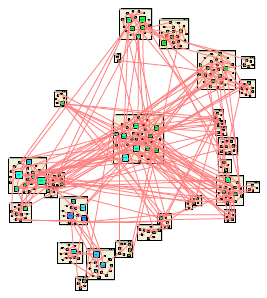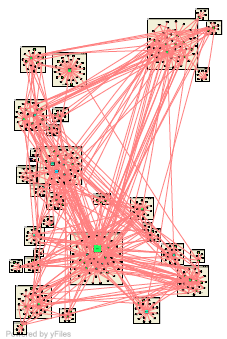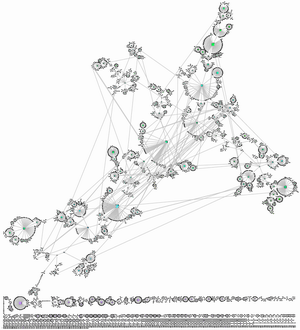October 14, 2006
Genealogy: the Next Generation
My previous post about cultural and academic genealogy of course deserves a sequel.
Mike Love pointed me to his latest dataset, so now I have redone my clustering of his genealogy. I also got interested in extracting a genealogy from the Wikipedia entries for philosophers, which often contain a "influenced by/influence to" box. So here are the results (click for PDF):
Love's network is to the left and the Wikipedia-derived one to the right. The Wikipedia network has a stronger focus just on philosophy, with many more "lesser greats" included (yet leaving out some real greats since they did not have clear lists of influence - I will deal with that later).
The clustering from yEd behaves a bit strangely in the new Love dataset. The greeks get split into three clusters centered around Socrates, Plato and Aristotle. Plato ends up together with Augustine and early Christian thinkers while Aristotle gets Aquinas. We get a very nice renaissance cluster. The central philosopher cluster now includes everyone from Descartes over Kant to Marx and Nietzsche. We still have a number of subdiscipline, author and artist clusters. My guess is that the removal of many A->C links because there is an A->B->C link has weakened many clusters while the web of mutual influence in the German Gang remains equally strong, preventing it from splitting into the classical philosophy and existentialism clusters I liked before.
On the other hand the Wikipedia network has almost the same cluster. Since it has many more people with just one inlink or outlink we get plenty of clusters that are the centered on one Big Name. We get a very nice separation of analytic philosophy, and a cluster just for marxism. But we get a messy cluster of Plato, Aristotle, Locke, Decartes and Adam Smith. Removing all people with just one link to the network cleans everything up nicely, but it makes even more of the classic philosophers end up in the central cluster.
Which is best? I think both have merits. Love's genealogy covers a broader range and does not include every little thinker. The Wikipedia network is much stronger for contemporary philosophy and the borderland towards politics where marxists and libertarians dwell. That we get clusters that make sense and roughly overlap is also nice: there seem to be some ground truth to these networks.
Academic Pedigree
My previous map of the philosophy family tree was nicely circular, but as a Gustaf Arrhenius immediately pointed out after seeing his entry, it lacked the cross-connections of multiple advisors. Adding these destroyed all the neat symmetry. In return we got an even bigger giant component, a big flying cross with Leibniz in the lower left corner and the Russel-Whitehead-Wittgenstein gang on the right arm.
As an aside, there seems to be lots of academic genealogy projects. Of particular note is the neuroscience family tree. That computer scientists through mathematicians can lead their ancestry back to Leibniz isn't that strange. But many neuroscientists also tie into the above network. Eric Kandel has Otto Mencke in his background, and Herman von Helmholtz has neuroscience and psychology descendants beside his physics and philosophy descendants.
It would be fun to actually merge all these academic graphs to see the big picture, but I will likely need a better layout program to handle it. The philosophers are <8000 and yEd handles them well, but the philosopher graph is just 8% of the mathematician graph.
Next step is to show the influence links on the pedigree graph, but I leave that for next week.
[I have also added these images to my Flickr networks photostream]
Posted by Anders3 at October 14, 2006 07:25 PM

